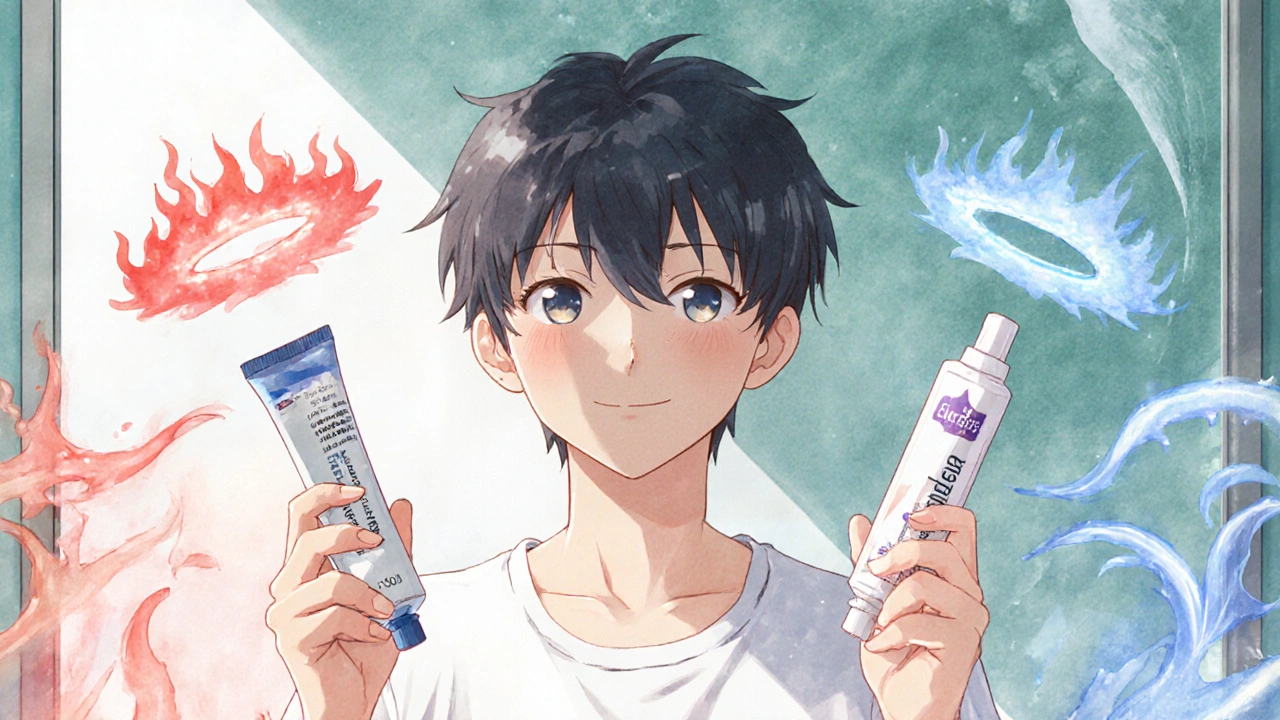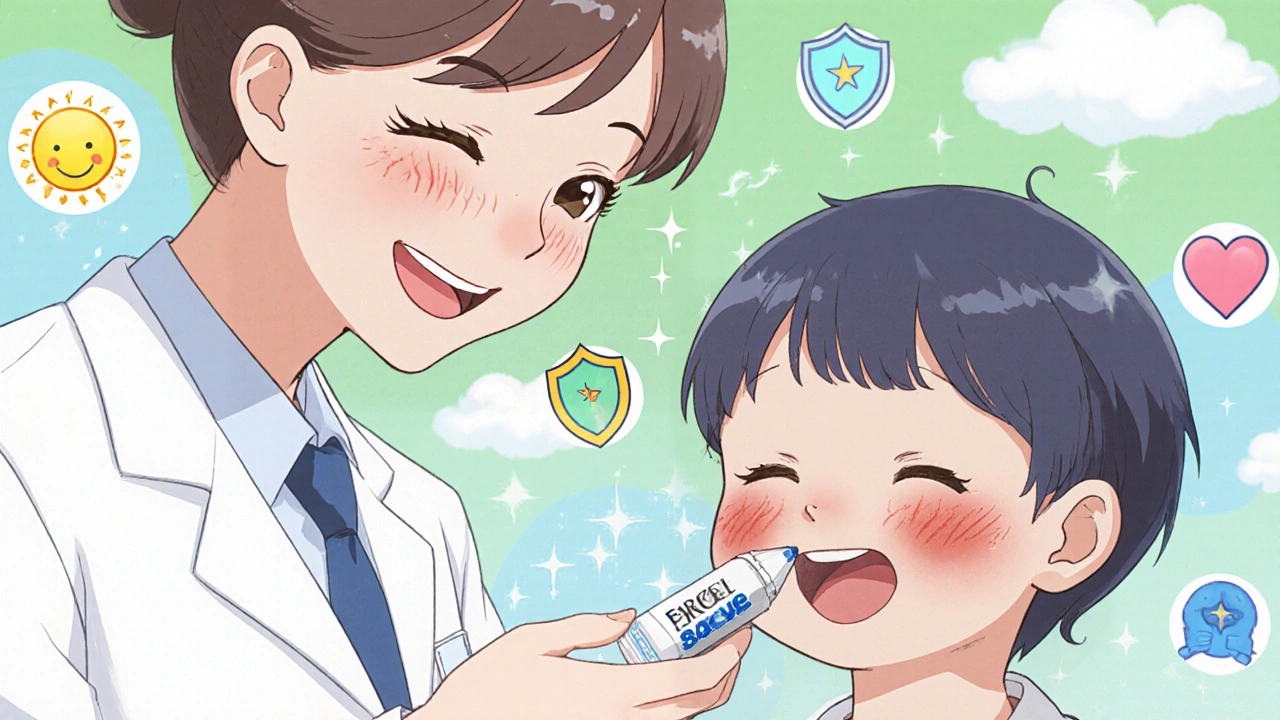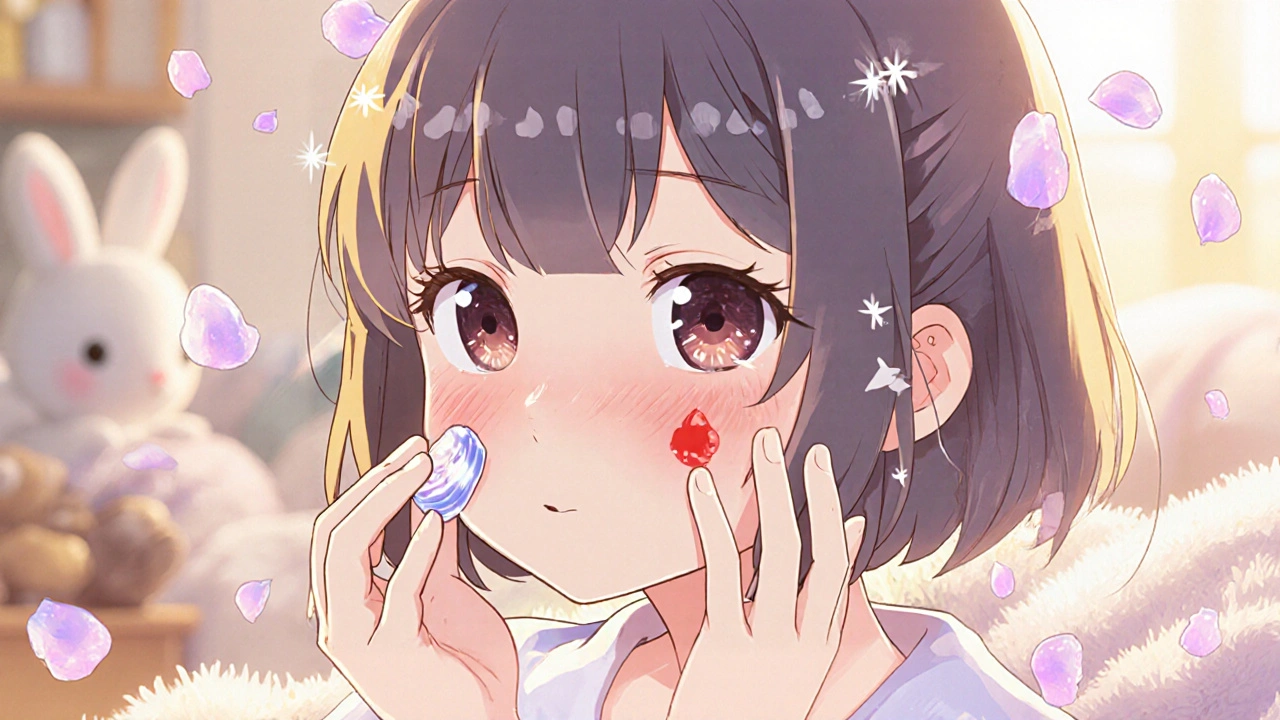Skin Treatment Comparison Tool
Find Your Best Skin Treatment
Answer a few questions to get personalized recommendations for eczema and skin inflammation treatment.
When your skin is red, itchy, and flaking, finding the right treatment isn’t just about comfort-it’s about stopping the cycle of irritation before it gets worse. Flutivate skin cream, which contains fluticasone, is a common prescription for eczema, psoriasis, and allergic skin reactions. But it’s not the only option. Many people wonder: Is Flutivate the best choice? Are there cheaper, gentler, or more effective alternatives? The answer depends on your skin type, how severe your flare-up is, and what your body responds to.
What Flutivate Skin Cream Actually Does
Flutivate contains fluticasone propionate, a medium-strength corticosteroid. It works by calming down your immune system’s overreaction in the skin. That means less redness, swelling, and itching. It’s not a cure-it’s a temporary fix for flare-ups. Most people see improvement within 3 to 5 days, with full results in 1 to 2 weeks. It’s usually applied once a day, in a thin layer, only on affected areas.
Fluticasone is classified as a Class IV corticosteroid in the U.S. and Class III in Europe-meaning it’s mid-range in strength. It’s stronger than hydrocortisone but weaker than clobetasol. This makes it a good middle-ground option for moderate eczema, especially on sensitive areas like the face or neck, where stronger steroids can cause thinning skin.
Why People Look for Alternatives
Even though Flutivate works well for many, it’s not perfect. Long-term use can lead to side effects like skin thinning, stretch marks, or even rebound flares when you stop. Some people can’t get a prescription because their doctor wants to avoid steroids altogether. Others find it too expensive-Flutivate can cost over $60 for a 30g tube without insurance. And then there are those who prefer non-steroidal options, especially for kids or chronic conditions.
That’s why alternatives matter. You don’t have to stick with one treatment if it’s not working-or if you’re worried about using it for too long.
Top Alternatives to Flutivate Skin Cream
Here are the most commonly prescribed and studied alternatives, broken down by type and use case.
1. Hydrocortisone Cream (1%)
Hydrocortisone is the most widely available over-the-counter steroid cream. It’s Class VII-the weakest. For mild eczema or a small patch of irritation, it can be enough. But if your skin is really inflamed, it won’t cut it. A 2023 review in the British Journal of Dermatology found hydrocortisone was 40% less effective than fluticasone for moderate-to-severe atopic dermatitis in adults.
Best for: Mild rashes, baby eczema, short-term use. Not for face or large areas.
2. Mometasone Furoate (Elocon)
Mometasone is another Class III steroid, very similar in strength to fluticasone. Studies show it’s just as effective for eczema and contact dermatitis. The big difference? It’s often cheaper and available in more formulations-gel, ointment, cream. Some users report less stinging on broken skin.
Best for: People who need the same strength as Flutivate but want a lower-cost option. Also good for scalp psoriasis.
3. Pimecrolimus Cream (Elidel)
This is a non-steroidal option. It’s an immunomodulator, meaning it changes how your skin’s immune cells behave without using steroids. It’s FDA-approved for mild-to-moderate eczema in adults and children over 2. No skin thinning. No rebound effect. But it can cause a burning sensation at first-about 1 in 3 users feel it.
Best for: Long-term maintenance, face or groin areas, kids, people avoiding steroids. Often used after a steroid course to keep flare-ups away.
4. Tacrolimus Ointment (Protopic)
Like Elidel, Protopic is non-steroidal. It’s stronger than pimecrolimus and often used for moderate-to-severe eczema. It’s especially helpful for areas where steroid use is risky-like around the eyes or on the neck. It’s not approved for children under 2. Side effects include burning and sensitivity to sunlight.
Best for: Chronic eczema, steroid-resistant cases, sensitive zones. Often prescribed after steroids fail.
5. Crisaborole Ointment (Eucrisa)
Another non-steroidal option, Crisaborole is a PDE4 inhibitor. It reduces inflammation at the cellular level. It’s approved for mild-to-moderate eczema in adults and children as young as 3 months. It doesn’t burn like Protopic. No systemic side effects. But it’s expensive-over $500 without insurance in the U.S.
Best for: Families wanting a steroid-free option for infants or toddlers. Also good for daily use on flare-prone areas.
6. Calcineurin Inhibitors vs Steroids: What’s the Difference?
Here’s how the main alternatives stack up against Flutivate:
| Product | Type | Strength | Best For | Side Effects | Age Approval |
|---|---|---|---|---|---|
| Flutivate (Fluticasone) | Topical Steroid | Medium (Class III/IV) | Moderate eczema, body and face | Thinning skin, stretch marks with long-term use | 2+ years |
| Hydrocortisone 1% | Topical Steroid | Low (Class VII) | Mild rashes, short-term relief | Minimal if used briefly | 2+ years |
| Mometasone (Elocon) | Topical Steroid | Medium (Class III) | Same as Flutivate, often cheaper | Similar to Flutivate | 2+ years |
| Pimecrolimus (Elidel) | Non-Steroidal | Medium | Face, neck, long-term use | Burning on first use | 2+ years |
| Tacrolimus (Protopic) | Non-Steroidal | High | Severe eczema, sensitive areas | Burning, sun sensitivity | 2+ years |
| Crisaborole (Eucrisa) | Non-Steroidal | Low-Medium | Infants, daily prevention | Mild irritation | 3+ months |

When to Use Steroids vs Non-Steroidals
Think of steroids like a fire extinguisher-they put out the fire fast. Non-steroidals are more like fire prevention: they reduce the chance of the fire starting again.
If you have a sudden, angry flare-up-red, swollen, painful-start with Flutivate or mometasone. Use it for 7 to 14 days, then stop. Don’t use it daily for months.
Once the flare is under control, switch to a non-steroidal like Elidel or Eucrisa to keep things calm. Many dermatologists recommend a “steroid-sparing” approach: use steroids only when needed, then switch to maintenance therapy.
This is especially important for kids. Their skin is thinner. Their bodies are still growing. Long-term steroid use can affect skin structure and hormone balance. Non-steroidals are safer for daily use over years.
What Doesn’t Work (And Why)
Not all alternatives are created equal. Some products you might think help-like coconut oil, aloe vera, or tea tree oil-don’t have strong evidence for treating eczema. A 2024 meta-analysis in JAMA Dermatology found that while coconut oil may moisturize, it doesn’t reduce inflammation like prescription creams. Tea tree oil can even irritate sensitive skin.
Also avoid mixing creams. Using two steroids together (like Flutivate and hydrocortisone) doesn’t make it stronger-it just increases side effect risk. And never use steroid creams on infected skin (oozing, crusted, or hot to the touch). You need an antibiotic first.
How to Choose the Right One for You
Here’s a simple decision guide:
- Is your eczema mild? Try hydrocortisone 1% first. If no improvement in 7 days, see a doctor.
- Is it moderate and on your face or neck? Flutivate or mometasone for 1-2 weeks, then switch to Elidel or Eucrisa.
- Is it severe or not responding to steroids? Protopic or Eucrisa. These need a prescription.
- Are you treating a baby or toddler? Eucrisa is safest for infants. Elidel for kids over 2.
- Do you need long-term control? Non-steroidals are your best bet. Use them daily, even when skin looks fine.
Always talk to your doctor before switching. They can check for skin infections, rule out other conditions like psoriasis, and adjust your plan.

Cost and Accessibility
Flutivate can cost $50-$80 without insurance. Mometasone is often $20-$40. Elidel and Protopic can be $400-$600, but many insurance plans cover them if you’ve tried steroids first. Eucrisa is expensive but sometimes has manufacturer coupons.
In New Zealand, Flutivate is subsidized under the Pharmaceutical Schedule. If you have a prescription, you’ll pay around $5-$15 per tube. Hydrocortisone is available over the counter for under $10. Non-steroidals are not subsidized here, so cost is a bigger barrier.
What to Do If Nothing Works
If you’ve tried Flutivate, mometasone, Elidel, and Eucrisa-and your skin still flares up-it might be time to consider other treatments. Phototherapy (light therapy), oral antihistamines for itching, or newer biologics like dupilumab (Dupixent) are options for severe, chronic cases. These require specialist care.
Also consider triggers: stress, harsh soaps, wool clothing, or even certain foods. Keeping a skin diary for 2 weeks can reveal patterns you didn’t notice.
Is Flutivate stronger than hydrocortisone?
Yes, Flutivate (fluticasone) is significantly stronger. Hydrocortisone 1% is a low-strength steroid, best for mild irritation. Flutivate is a medium-strength steroid and works better for moderate eczema, psoriasis, or allergic reactions. Using hydrocortisone on a severe flare-up often won’t help enough.
Can I use Flutivate on my face?
Yes, but only for short periods-no more than 7 to 10 days. The skin on your face is thinner and more sensitive. Long-term use can cause redness, acne, or skin thinning. If you need ongoing treatment for facial eczema, non-steroidal creams like Elidel or Eucrisa are safer.
How long does it take for Flutivate to work?
Most people notice less itching and redness within 3 to 5 days. Full improvement usually takes 1 to 2 weeks. Don’t keep using it longer than your doctor recommends-even if it seems to be working. Overuse raises the risk of side effects.
Are non-steroidal creams better than steroids?
Not necessarily better-just different. Steroids work faster and are more powerful for acute flares. Non-steroidals are safer for long-term use and don’t cause skin thinning. Many doctors use steroids to calm a flare, then switch to non-steroidals to prevent the next one.
Can I buy Flutivate without a prescription?
No. Flutivate is a prescription-only medication in most countries, including New Zealand, the U.S., and the UK. Even though it’s a topical cream, it’s a controlled steroid and requires medical supervision. Over-the-counter hydrocortisone is the only legal alternative without a prescription.
Final Thoughts
Flutivate is a solid choice for moderate skin inflammation-but it’s not the only one. If you’ve been using it for months and still have flare-ups, it’s time to rethink your plan. Alternatives like mometasone, Elidel, or Eucrisa can be just as effective with fewer long-term risks. The goal isn’t just to clear your skin today-it’s to keep it calm for months and years to come. Talk to your doctor about what fits your skin, your lifestyle, and your long-term health.

krishna raut
October 31, 2025 AT 12:26Flutivate works great for moderate eczema, but don't overuse it. I've seen too many people ruin their skin barrier by applying it daily for months. Stick to 7-10 days max, then switch to Elidel or Eucrisa. Simple.
Prakash pawar
November 2, 2025 AT 03:26Look man we been conditioned to fear steroids like theyre the devil but truth is nature dont care about your fear its just chemistry and your body knows what to do if you let it but doctors wanna sell you pills so they make you scared of the cure itself
MOLLY SURNO
November 2, 2025 AT 15:29This is one of the most balanced and well-researched posts I've read on eczema treatments. The breakdown of steroid vs non-steroidal options is incredibly helpful, especially for patients who are new to managing chronic skin conditions. Thank you for including age-specific recommendations and cost considerations.
Alex Hundert
November 3, 2025 AT 17:25Stop letting big pharma scare you into thinking non-steroidals are 'better.' They're not. Flutivate works faster, cheaper, and more reliably. If you're afraid of side effects, use it for two weeks like the guidelines say-not for years. The real problem is people who don't follow directions, not the medication.
Emily Kidd
November 5, 2025 AT 01:37so i tried elidel after flutivate and yeah it burned like hell at first but after 3 days it was chill and my face stopped flaking. i use it every night now like a moisturizer. no redness, no thinning skin. totally worth it even if it cost 500 bucks. my dermatologist said i can use it forever basically.
Justin Cheah
November 5, 2025 AT 14:35Have you ever stopped to think that the FDA and dermatology associations are all just fronts for Big Pharma? Flutivate was pushed hard because it's patented and profitable. But look at the real data-topical calcineurin inhibitors like Protopic were banned in Europe for years because they caused cancer in mice. They let it back in after lawsuits. Why? Because they need you to keep buying expensive creams instead of fixing your gut or your stress. The truth is hidden behind medical jargon. You think you're healing your skin? You're just feeding the machine.
caiden gilbert
November 6, 2025 AT 08:28Flutivate is like a sledgehammer to a mosquito problem. It works, sure-but sometimes you just need a fly swatter. Eucrisa? That’s the quiet whisper that keeps the peace. No drama, no burning, no scary side effects. I use it every morning like brushing my teeth. My skin doesn’t scream anymore. Just hums. Quietly. Peacefully. Like it’s supposed to.
phenter mine
November 7, 2025 AT 14:09i just wanna say i used mometasone instead of flutivate and it was way cheaper and worked just as good. my doc said its the same strength so why pay more? also i got it from canada online and saved like 60 bucks. dont let them rip you off.
Aditya Singh
November 8, 2025 AT 16:07Actually, your entire analysis is fundamentally flawed because you're conflating immunomodulatory mechanisms with anti-inflammatory efficacy. Fluticasone propionate inhibits NF-kB translocation via glucocorticoid receptor dimerization, whereas pimecrolimus binds calcineurin-two distinct pathways. The clinical equivalence you're implying is statistically insignificant in phase III trials. Also, you ignored the cytokine profile differences in Th2-dominant eczema. And why are you recommending Eucrisa for infants? The PDE4 inhibition profile in neonates isn't fully characterized. This is dangerous advice.
Katherine Reinarz
November 10, 2025 AT 02:02i used flutivate for 3 weeks and my skin started peeling off like a snake and i cried every night and my boyfriend left me because he said i looked like a zombie and now i have scars and i hate my life and i just want to die
John Kane
November 11, 2025 AT 09:41Hey everyone-just want to say this post is a gift. Seriously. I’ve been living with eczema since I was 5, and I’ve tried everything from oatmeal baths to acupuncture. What really clicked for me was the steroid-sparing approach. I used Flutivate for two weeks during a brutal flare, then switched to Elidel. Now I use it every night. My skin hasn’t flared in 11 months. I’m not saying it’s perfect-but it’s sustainable. And if you’re a parent reading this? You’re not alone. Talk to your pediatric dermatologist. Ask about Eucrisa. It’s expensive, yes, but my daughter’s skin is soft again. That’s worth more than money. Keep going. You’ve got this.
Callum Breden
November 11, 2025 AT 17:55While the content is superficially informative, the absence of any reference to the 2021 Cochrane Review on topical corticosteroid potency grading, coupled with the uncritical endorsement of non-steroidal agents without addressing their black box warnings, renders this piece academically negligent. Furthermore, the recommendation to use Flutivate on facial skin for up to ten days is in direct contravention of the British Association of Dermatologists’ 2023 guidelines, which advise a maximum of five days. This is irresponsible.
Carolyn Kiger
November 13, 2025 AT 16:18Thank you for sharing this. I’m a nurse and I see so many patients scared to use steroids-or using them way too long. Your breakdown of when to switch to non-steroidals is exactly what we need more of. Keep spreading this kind of clarity.
Mike Gordon
November 15, 2025 AT 04:19One thing no one talks about-moisturizer timing. Apply your steroid or non-steroid cream on damp skin, right after a lukewarm shower. Locks it in better. I used to just slap it on dry skin and wondered why nothing worked. Game changer.